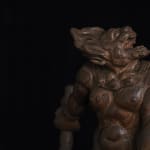Hirakushi Denchū (1872–1979)
Dialogue
Incised “Rochu Taku kore o tsukuru” on the base
With a box signed by the artist (1960)
W26.5 x H34.5 cm
Further images
This demon holds an iron club in his left hand. With hair swept back, he gazes into the heavens with mouth wide open as if shouting.
Denchu’s predilection for representations of the body and musculature is clearly visible in the dynamic skin depiction of his 1920 work Reincarnation. Denchu planned to work on a series of ten demon carvings after the completion of Reincarnation. One reason for Denchu’s interest in demons was probably because they were ideally suited to portrayals of acrobatic postures and half-naked figures. He could also use the tree-ring wood pattern to tremendous effect to trace the rippling demon muscles in an extremely naturalistic way.
Denchu has written “March, Showa 35 (1960)” and “This is an earlier work that I have now named” on this sculpture’s box. He has also has written the title Dialogue, but he is not known to have made any similarly-named works, so it is unclear whether this title is based on a story or legend. However, some temples and shrines in the Kanto area still hold a traditional Setsubun ceremony in February called “Oni Mondo,” or “Demon Dialogue,” so perhaps Denchu recalled scenes from this ceremony when he saw this image of a shouting demon.
Hirakushi Denchu (wood sculptor; 1872–1979)
Okayama-born wood sculptor. His real name is Takutaro. First learned wood-carving under Nakatani Seiko, a doll maker, and became a student of Takamura Koun. Involved in the founding of Nihon chokoku-kai (Japan Sculptors Association), and his work exhibited at its first show was recognized by Okakura Tenshin. Appointed Tokyo University of the Arts professor. An Imperial Court Artist, the Japan Art Academy member. Designated as a Person of Cultural Merit, and received the Order of Culture.
Denchu’s predilection for representations of the body and musculature is clearly visible in the dynamic skin depiction of his 1920 work Reincarnation. Denchu planned to work on a series of ten demon carvings after the completion of Reincarnation. One reason for Denchu’s interest in demons was probably because they were ideally suited to portrayals of acrobatic postures and half-naked figures. He could also use the tree-ring wood pattern to tremendous effect to trace the rippling demon muscles in an extremely naturalistic way.
Denchu has written “March, Showa 35 (1960)” and “This is an earlier work that I have now named” on this sculpture’s box. He has also has written the title Dialogue, but he is not known to have made any similarly-named works, so it is unclear whether this title is based on a story or legend. However, some temples and shrines in the Kanto area still hold a traditional Setsubun ceremony in February called “Oni Mondo,” or “Demon Dialogue,” so perhaps Denchu recalled scenes from this ceremony when he saw this image of a shouting demon.
Hirakushi Denchu (wood sculptor; 1872–1979)
Okayama-born wood sculptor. His real name is Takutaro. First learned wood-carving under Nakatani Seiko, a doll maker, and became a student of Takamura Koun. Involved in the founding of Nihon chokoku-kai (Japan Sculptors Association), and his work exhibited at its first show was recognized by Okakura Tenshin. Appointed Tokyo University of the Arts professor. An Imperial Court Artist, the Japan Art Academy member. Designated as a Person of Cultural Merit, and received the Order of Culture.









